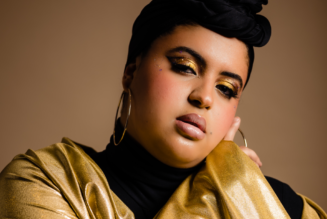“I am forever chasing The Marshall Mathers LP. That was the height of what I could do. I just don’t have the rage I did back then.”– Eminem, 2017 Vulture interview
“It sounded like something Stephen King would write. It sounded like a horror movie.” – Jimmy Iovine, VH1’s Ultimate Albums – Eminem: The Marshall Mathers LP
Jan. 20, 2001. The Barker Hangar. Santa Monica, CA. 2.5 miles from the Interscope Records office.
He emerges wearing denim overalls and wielding a chainsaw. Chemically blonde hair meets the top of a hockey mask. Behind him on stage, an ersatz brick bungalow modeled after an equally weathered home somewhere between 8 Mile and 7 Mile roads in Detroit. The chainsaw blade is inert, but a recording of violent revving plays as sparks shoot skyward from the stage. When the DJ cuts the chainsaw recording, he chucks the prop aside. Mischievous guitar chords, the aural equivalent of a caped cartoon villain tiptoeing behind an unsuspecting mark, sound in concert with thousands of screams. He pulls a microphone from his pocket and lifts the mask.
It’s Marshall Mathers. Slim Shady. Eminem. This is his first nationally televised full-length concert, a private performance of his 2000 Anger Management Tour set taped by In Demand, then the top pay-per-view distributor in the U.S. (You can still watch most of it here.)
The subtext, which may or may not be obvious to the audience of predominantly white (and probably moneyed) teens, is this: the rock bottom life endured in and outside of that Detroit home spawned the man (Mathers) turned rapper (Eminem) with an alter ego (Shady) who stands before them as a hybrid of horror-movie homicidal maniacs. Swooning girls and guys in Ecko beanies scream ecstatically, not in abject terror. Graphic rhymes about rape, incestuous rape, domestic violence, and gruesome murder are welcome, desired. If the video editor later soundtracked footage of the crowd with hits from *NSYNC or Backstreet Boys — and cut out the seconds where a young woman mouths “suck my dick” — they could’ve gotten away with it.
Today, the image of Anger Management Tour Eminem ranks among the most iconic shots of the best-selling rapper of all-time. The theatrics work out of context, but the serial killer look resonates most in light of how well it encapsulated Eminem’s persona on-record and in the public imagination during the release and reception of his greatest album, 2000’s The Marshall Mathers LP. He was the nightmare of suburban mothers, the lyrically sadistic superhero of disaffected teens who hated MTV. Jason Voorhees (hockey mask) and Leatherface (chainsaw) were as fictional as their victims, but you could look Eminem in his blue eyes. The victims of his multisyllabic assaults — his baby mama, his mother, the president, pop artists, Christopher Reeves, Insane Clown Posse, women, gay men — were real. His looks and his lyrics both put him on the cover of magazines (Rolling Stone, SPIN, VIBE) that perpetuated the image. The Source, which made Eminem the first white cover star in its then-12-year history, went with the overalls and chainsaw.
Three days after the Barker Hangar show, the RIAA certified Marshall Mathers eight-times platinum. (It reached diamond-status in 2011 and became the second highest-selling single disc rap album of all time.) A month later, Marshall Mathers won Grammys for Best Rap Album and Best Rap Solo Performance (“The Real Slim Shady”). Practically every Eminem album has debuted at No. 1, and many have won Grammys, but each is either a prologue or postscript to Marshall Mathers.
Twenty years old this week, Marshall Mathers LP is the record the rest of his catalog is measured against. It cemented his place in the pantheon. If you include him in rap’s enduring GOAT conversation, as Zadie Smith did in her 2002 VIBE cover story, you point to Eminem’s incendiary third album with one hand and extend the middle finger of the other.
Eminem’s rhymes and wit were never sharper, his narratives never more convincing. He was a chainsaw with endless fuel, on ecstasy but never on E. Antagonistic and angered, political and politically incorrect, jesting and juvenile — he cut down enemies and innocents like it was an autonomic function. Apart from “Kim,” the grotesque and screaming diatribe, his delivery was never more fluid or in the pocket. Chalk it up to the right combination of THC, pain pills and hallucinogens, the production from Mel-Man, the Bass Brothers, or Dre’s coaching.
“[Dre] showed me how to deliver rhymes over a beat, and he showed me that you stick with something until you have it just how you want it,” Eminem told The Los Angeles Times in 2000.
Listening to verses of interlocking internal and end rhymes on “Kill You” or even lead single “The Real Slim Shady” is like watching a gymnast solve a Rubik’s Cube while performing a flawless Triple Double during a floor routine. Syllables in each block of language rotate swiftly on their axis, aligning as though they couldn’t be arranged another way. He flips in and out of cadences and character voices without a sidestep, perhaps only as a medaling Rap Olympian can. The following lines from “I’m Back” illustrate the extent of his syllabic intricacy, but nothing rivals listening to him spring from one phrase to the next:
“Mind with no sense in it, fried schizophrenic, whose eyes / Get so squinted, I’m blind from smoke in ’em, with my windows tinted / With nine limos rented, doin’ lines of coke in ’em / With a bunch of guys hoppin’ out, all high and indo-scented”
The linguistic acrobatics of The Marshall Mathers LP were on par with Eminem’s palpable rage and the provocativeness of the content. Like its predecessor The Slim Shady LP, the album captured America’s attention, all but dominated the discourse of rap and pop music as rap continued its ascent to the top of the charts. Yet Eminem seemingly encouraged violence against women and condoned rape and gay-bashing. Or was it all a joke?
“I take the things that are messed up with the world and the things that are twisted and I poke fun at them,” he told MTV in 1999. “I think anyone with half a brain is going to be able to tell when I’m joking and when I’m not.”
Like Bret Easton Ellis’s American Psycho, which captivated and appalled readers long before Slim Shady bleached his hair, the line between sincerity and absurdity on Marshall Mathers was soaked in arterial red. Most journalists reviewed the record positively, but detractors didn’t see the humor or rejected its very premise. In 2000, the same year moviegoers watched Christian Bale chase a prostitute with a chainsaw in the American Psycho adaptation, Eminem became the target of politicians and activists. His violent lyrics were the focal point of Senate hearings, his homophobic ones incited GLAAD protests outside of the Grammys.
Yet Marshall Mathers LP remains one of the most critically-acclaimed, commercially-successful, and influential albums in rap history. The list of rappers Eminem influenced at his peak includes Tyler, the Creator, Earl Sweatshirt, Kendrick Lamar, and late Juice WRLD. How did Eminem come to write such deranged rhymes, and what made them irresistible to so many? What did the album’s ubiquity say about us?
The plot points of Marshall Mathers’ early life are well-documented. You can read about the bullies who beat him senseless and his turbulent homelife (abandoned by dad, neglected and psychologically abused by pill-popping mom) everywhere. It follows that he would gravitate toward rap, an art where skill supplants brawn. Bullies in school and at home couldn’t silence him in the cipher.
At Detroit venues like the Hip-Hop Shop, Mathers became Eminem, battling opponents who dismissed him for being white in a black art form. Technique and punchlines were paramount, but violence was the lingua Franca. Diss someone’s appearance, question their masculinity or heterosexuality, threaten extreme physical harm — all were fair game. Still, everyone involved assumed murderous intent was as figurative. For better and worse, Eminem has searched for formidable sparring partners ever since.
His alter-ego, Slim Shady became a vehicle for every irate and demented thought that came with a rhyme scheme. Shady was the ID unbound, while Mathers grappled with fatherhood, traced the scars of his upbringing. Eminem was the bridging the divide and blurring the line between Slim’s psychotic fantasies and Mathers’ infuriated reality.
“Slim Shady is a name for my temper or anger,” Eminem told SPIN in 2000. “Eminem is just the rapper, Slim Shady is the attitude behind him, and Marshall Mathers is who I am at the end of the day.”
Without Dr. Dre, Eminem might’ve never made it out of Detroit. After the Death Row fallout, Dre’s label Aftermath was off to a rocky start. The Firm didn’t flop, but The Album (1997) didn’t do The Chronic numbers. In 1998, Interscope head and eventual-headphone-salesman Jimmy Iovine passed The Slim Shady LP to a beleaguered Dre. The man who beat Dee Barnes heard Eminem rap about killing his baby mama (“Just the Two of Us”) and was sold. Eminem became Neo to Dre’s Morpheus, “the one” to save Aftermath and crack the code of the pop Matrix-like no rapper before him.
Amidst unprecedented acclaim for The Silm Shady LP and the hassles of its attendant fame, constant criticism, and lawsuits, Eminem went on a world tour in 1999. Between frustrating interviews and an inebriated sojourn in Amsterdam, he began penning songs for Marshall Mathers. When he returned to the states, he logged marathon recording sessions in L.A. (with Dre and Mel-Man) and Detroit (with the Bass Brothers). He delivered a 16-track version of Marshall Mathers LP to Interscope in March of 2000, just over a year after The Slim Shady LP. At the behest of Iovine, Eminem recorded a commercially friendly single.
“The Real Slim Shady” was a spiritual sequel to “My Name Is.” A reintroduction to Slim Shady with another simple and catchy chorus that you hate to love. Dre and Mel-Man made a thumping, carnivalesque beat that somehow aurally approximated Shady’s playfully dark essence and left room for his attacks. Pissed about appearing on music video countdowns next to pop acts, Shady took shots at boy bands, Britney Spears, and Will Smith. He fired back at Christina Aguilera for a perceived character assassination. It’s difficult to imagine Marshall Mathers having the same impact without Eminem stalking into the MTV Awards with a platoon of doppelgangers behind him. Tonally, though, “The Real Slim Shady” is at odds with its surroundings.
Marshall Mathers was a gallery of horrors inspired by Eminem’s critics and fans. Other multiplatinum musicians had become scapegoats for deeper societal problems (e.g., gun control, mental health awareness), so Eminem gave his persecutors the monster they wanted. Moralists deplored his lines about violence and rape, so he choked a woman to death before raping his mother on “Kill You” and made it the first song. Gay activists called his lyrics homophobic, so he said he claimed to “hate fags” and joked about Gianni Versace’s assassination in “Criminal.” On the record (e.g., “Who Knew”) and in interviews, he denied any culpability for doubling down.
“I don’t think music can make you kill or rape someone any more than a movie is going to make you do something you know is wrong,” he told the LA Times less facetiously, “but music can give you strength.”
To explain by way of example, Eminem made “Stan.” Inspired by 45 King’s brilliant flip of a Dido sample, he took the beat and wrote a nearly seven-minute epistolary horror about an obsessed fan who takes every lyric to heart. It was rap’s answer to Stephen King’s Misery. The music video is Devon Sawa’s best work, but each verse was so vivid and well scripted that you didn’t need it. You just had to listen to the words, the torrential storm, and the sound of someone scribbling on paper at the bottom of the mix. Eminem becomes Stan for three verses, Stan’s desire for acknowledgment growing in conjunction with his rage at not receiving it. After the plot twist, Eminem responds to remind Stan that he’s “just clownin’” and urges him to get “some counseling.” After standing in front of screaming faces on TRL and dealing with overzealous fans on tour, “Stan” was a call for America to reevaluate celebrity and our relationship to it. We listened and loved the song, but too few absorbed the message. Today “stan” is in the dictionary, synonymous with fans who tweet in all caps about their favorite musician and attack anyone who diverges from their myopic evangelizing.
Though he displayed some empathy on “Stan”, Eminem aimed 2Pacian intensity and anger at invasive fans on the self-produced “The Way I Am.” But they weren’t the only target. Smug and bigoted interviewers (like Howard Stern), parents and politicians blaming the Columbine shooting on Marilyn Manson, people while turning a blind eye to the crack epidemic ravaging impoverished communities of color— Eminem flipped one middle finger after another at each group over funereal keys and an ominous church-bell. Despite what anyone might have written about him, there were boundaries in which he believed and prejudices he couldn’t abide.
As Eminem undoubtedly knew, though, Marshall Mathers wasn’t going to solve any of his problems. With the album’s popularity soaring, Lynne Cheney wrote to the two women members on the board of Seagram’s, which owned Interscope, and decried what the album was “doing to their children’s culture on “Violence in the Media.” With no fear of redundancy, she called his lyrics “shameful,” “dreadful,” and “awful” before asking what Marshall Mathers was “doing to their children’s culture.” Years later, she was less concerned about how kids might interpret her husband’s advocacy of waterboard torture or the massacre of innocent Iraqis.
While raping your mother and killing your wife is shameful, dreadful and awful, so is Eminem’s egregious and extensive gay-bashing. “Criminal,” though, remains the most indefensible. He raps, “Come on, relax, guy! I like gay men,” but the damage done by “…hate fags? The answer’s yes” is irrevocable. Eminem attacked a marginalized community to piss off critics. As with many victims of bullying, it’s unfortunate that Eminem didn’t realize when he’d become one himself.
Scars and all, MMLP remains a landmark achievement. It expanded the narrative possibilities in rap and the flexibility of the English language. It elevated the bar for wordplay forever. “Bitch Please II” is one of the greatest posse cuts of all time in spite of Eminem’s gleeful anti-gay language at the end. There’s no wonder why Eminem has chased an achievement of Marshall Mathers LP’s stature ever since. Sadly, the urgency and quality of his music leveled off before crashing dramatically. Every year, he becomes an increasingly grating parody of himself. He’s matured some (see “Like Home”), but his rhymes are rigid and filled with one-liners that inspire more cringes than most of Marshall Mathers.
Today, Eminem’s biggest artistic statement reminds us both of how much our culture has evolved and regressed. Intentionally and not, Eminem also forced listeners to probe their definitions of entertainment and art while investigating their prejudices. The hate and violence on the album reflected the ugliest parts of America at the dawn of the new millennium. We were decades away from the #MeToo Movement and the progress it made for victims of sexual violence. This record came out in an era when people said “gay” and “don’t be a fag” casually, ignorant of the hatred embedded in their diction. In the mid-aughts, everyone from Kanye West to Lil Wayne rapped “no homo.” It was only this year that Lil Nas X became the first gay rapper to win a Grammy.
No matter what progress we’ve made, we still have a racist, misogynist, and transphobic president with dozens of sexual assault accusations in office whose negligence during a pandemic has killed thousands of people. When Eminem gave America a monster on Marshall Mathers LP, at least he was kidding. Mostly.











